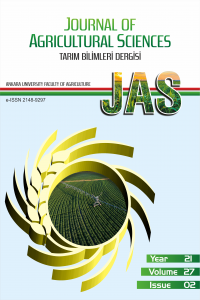Kırsal Rekreasyonel Faaliyetlerde Kısıtlayıcılar
Bu çalışmanın amacı A.İ.B.Ü. Düzce Yerleşkesi’ndeki öğrencilerin kırsal rekreasyon faaliyetlerine katılım sıklıklarını ve bu katılım sıklıklarını etkileyen kısıtlayıcıları saptamaktır. Bu amaçla 2004 bahar döneminde 250 kişiye anket uygulanmıştır. Katılımların ve kısıtlayıcıları ölçülmesinde beş noktalı Likert ölçeği kullanılmıştır. Elde edilen verilerden kısıtlayıcıları tiplerini belirlemek için faktör analizinden yararlanılmıştır. Buna göre kısıtlayıcıları, kişinin fizyolojik özellikleri, arkadaşları, ekonomik durumu, kendine olan güveni, alan yetersizliği, kişisel içsel, ruhsal nedenler, zaman olarak gruplanmaktadır
Anahtar Kelimeler:
Düzce, kırsal, rekreasyon, kısıtlayıcılar
Constraints in Rural Recreation Activities
The purpose of the study is to determine both the frequency of participation to recreational activities, and the constrains that effect participation frequency. For this purpose and inquiry has been done with 250 people in 2004 spring semester. Five point Likert scale has been used to evaluate the constrains and participations. In order to determine the types of constrains from the data obtained factor analize has been used. According to this, the constrains can be grouped as follows, a person’s physiology, friends, economic status, self- respect, lack of recreation sites, interpersonal reasons, and time
Keywords:
Düzce, rural, recreation, constrains,
___
- Annett, S., C. Dabrowski and R. A. Robertson, 1995. Motivations and constraints to spring break travel: A cross gender. Proceedings of the 1995 Northeastern Recreation Research Symposium. New York. 217-221
- Confer, J. J., H. Vogelsong , A. R. Graefe, D. S. Solan and J. K. Kramp, 1996. Relationships between motivations and recreation activity preferences among Delaware State Park visitors: an exploratory analysis. Proceedings of the 1996 Northeastern Recreation Research Symposium. New York. 146-153.
- Crawford, D. W., G. Godbey, 1987. Reconceptualizing barriers to family leisure. Leisure Sciences, 9: 119-127.
- Crawford, D. W., E. L. Jackson and G. Godbey, 1991. A hierarchical model of leisure constraints. Leisure Sciences, 13: 309-320.
- Dawyer, J. F. 1994. Customer Diversity and The Future Demand for Outdoor Recreation. Rocky Mountain Forest and Range Experiment Station, GTR/RM-252.
- Jackson, E. L., V. C. Rucks, 1995. Negotiation of leisure constrain, ts by Junior-high and high-school students: An exploratory study. Journal of Leisure Research, 27 (1): 85- 105
- Kinnaird, V., D. Hall, 1994. Tourism: A gender analysis. Chichester, England: John Wiley and Sons
- Oh, S. S., S. Y. Oh and L. L. Caldwell, 2001. The effects of perceived leisure constraints among Korean University students. Proceedings of the 2001 Northeastern Recreation Research Symposium. New York.183-187
- Samdahl, D. M., N. J. Jekubovich, 1997. A critique of leisure constraints: Comparative analyses and understandings. Journal of Leisure Research, 29: 430-452.
- Shaw, S. M., A. Bonen and J. F. McCabe, 1991. Do more constraints mean less leisure? Examining the relationship between constraints and participation. Journal of Leisure Research, 23: 286-300
- Vogelsong, H., A. R. Graefe, J. J. Confer, D. S. Solan and J. K. Kramp, 1997. Relationships between motivations and recreation activity preferences among Delaware State Park visitors: an exploratory analysis. Proceedings of the 1997 Northeastern Recreation Research Symposium. New York. 124-127.
- ISSN: 1300-7580
- Yayın Aralığı: Yılda 4 Sayı
- Başlangıç: 1995
- Yayıncı: Ankara Üniversitesi
Sayıdaki Diğer Makaleler
Tritikale Xtriticosecale Wittmack Hatlarının Tane Verimi ve Bazı Özelliklerinin Belirlenmesi
Zeki MUT, Sebahattin ALBAYRAK, Özgür TÖNGEL
Bazı Tritikale Çeşit ve Hatlarının Morfolojik Karakterizasyonu
Mehmet ATAK, Cemalettin Yaşar ÇİFTÇİ
Physokermes piceae Schrank Yumrulu Ladin Koşnili Hemiptera: Coccidae ’nin Biyolojik Özellikleri
Sema TURGUTER, Selma ÜLGENTÜRK
Kırsal Rekreasyonel Faaliyetlerde Kısıtlayıcılar
Nilsun DEMİR, Elif Lütfiye KUTAY, Sevil ÖRNEKCİ EŞEN
Toprak Özelliklerinin Tahmininde Sayısallaştırılmış Renk Parametrelerinin Kullanımı
